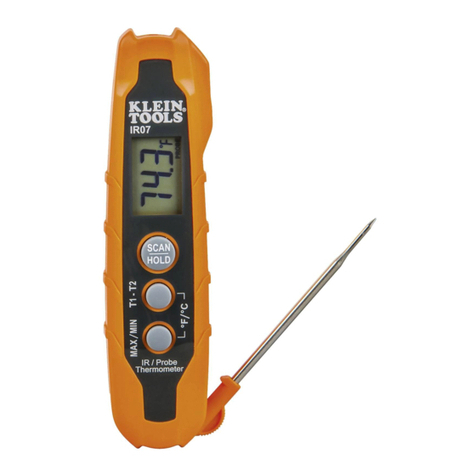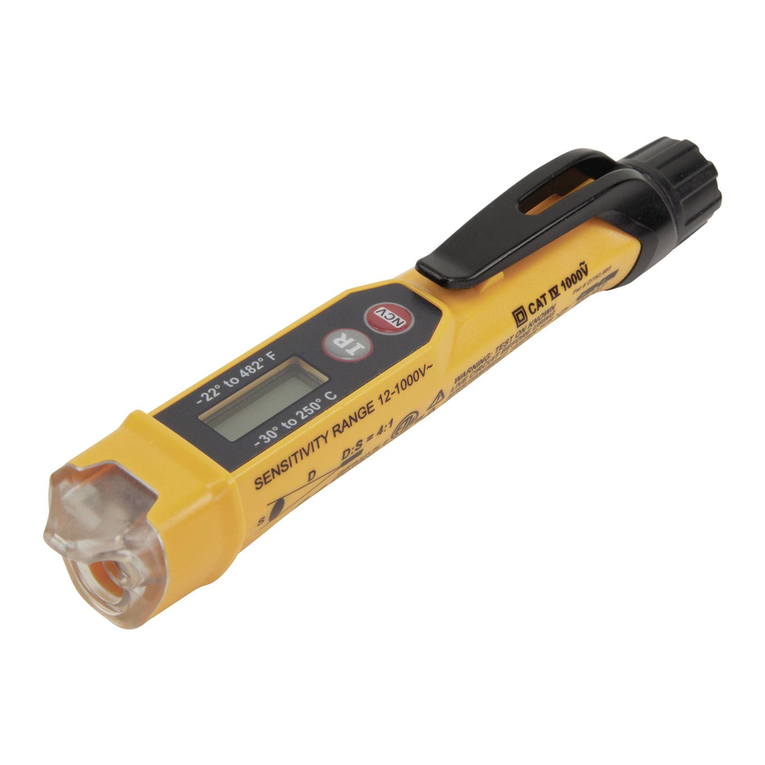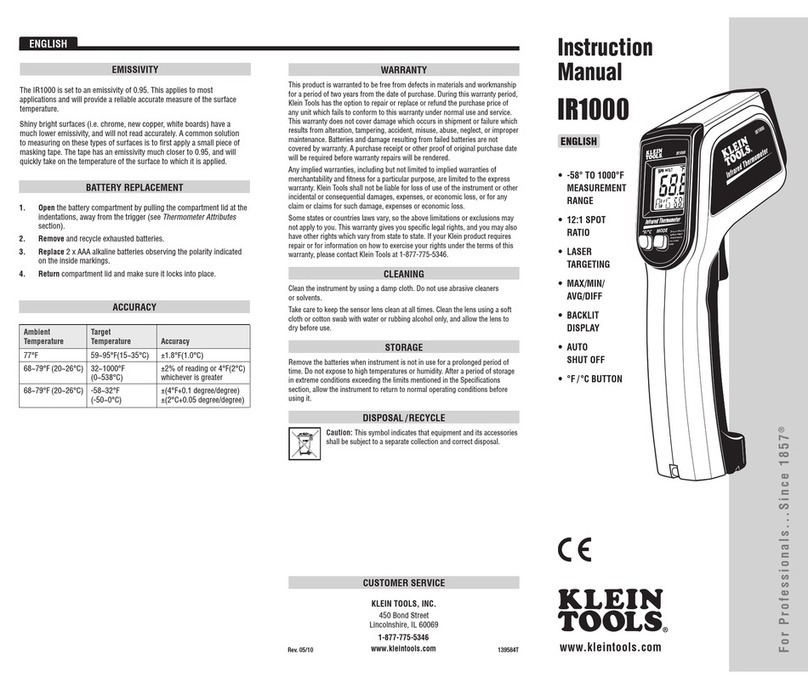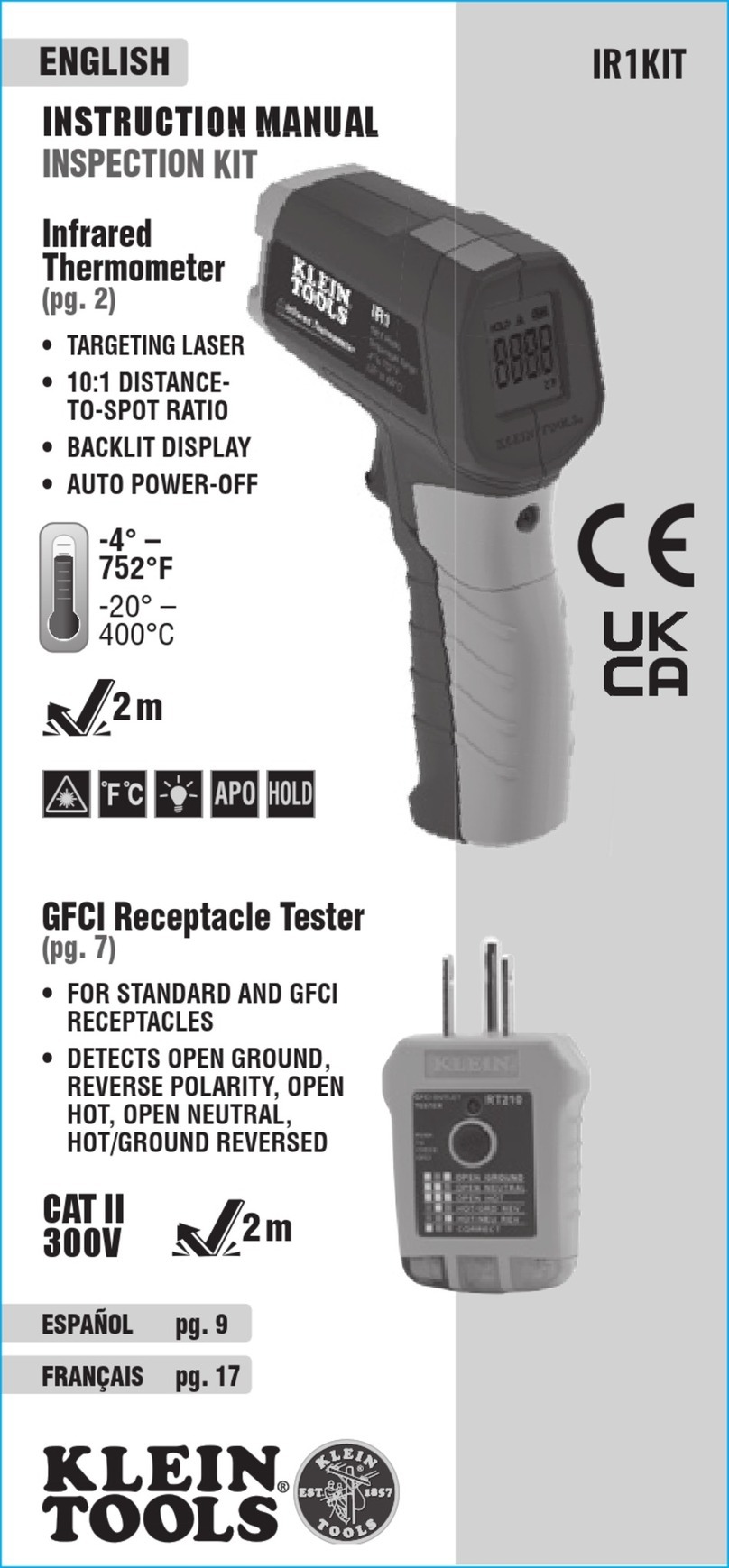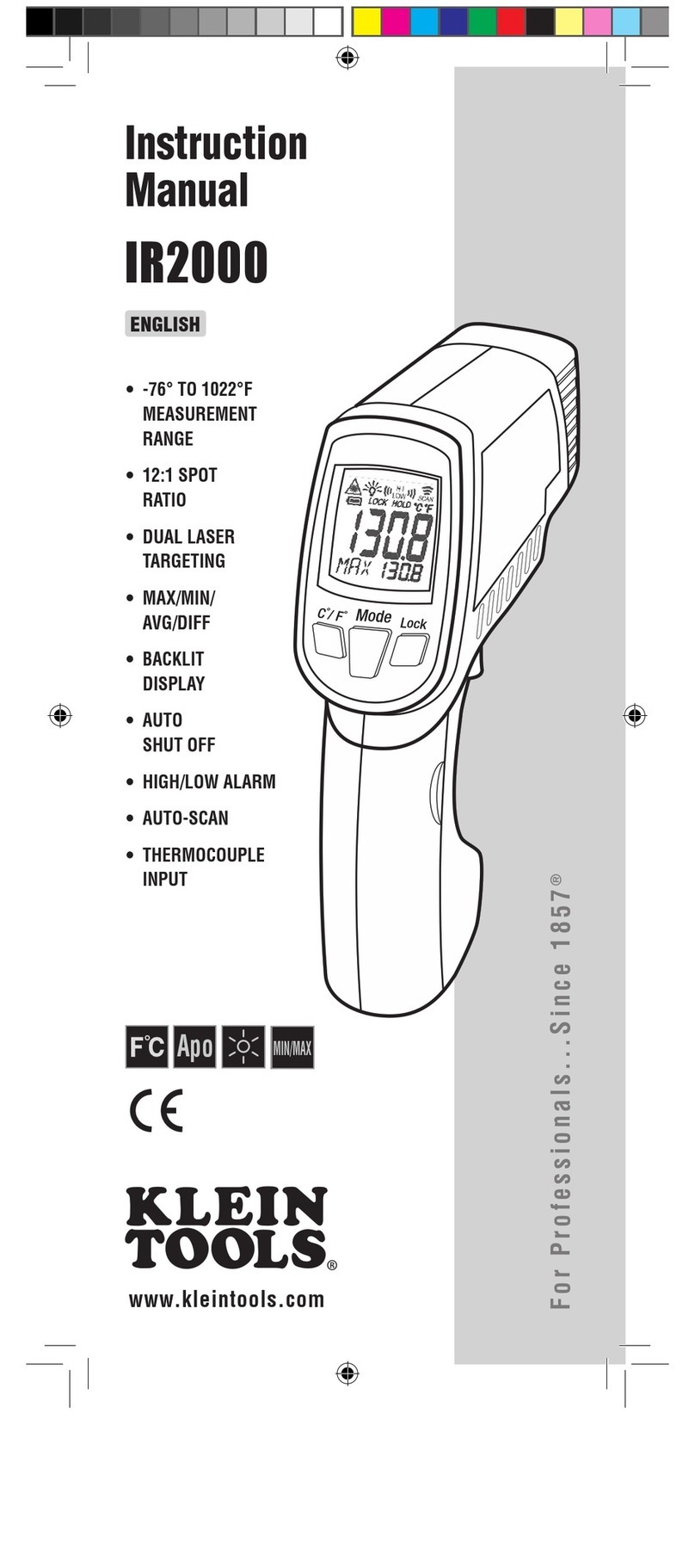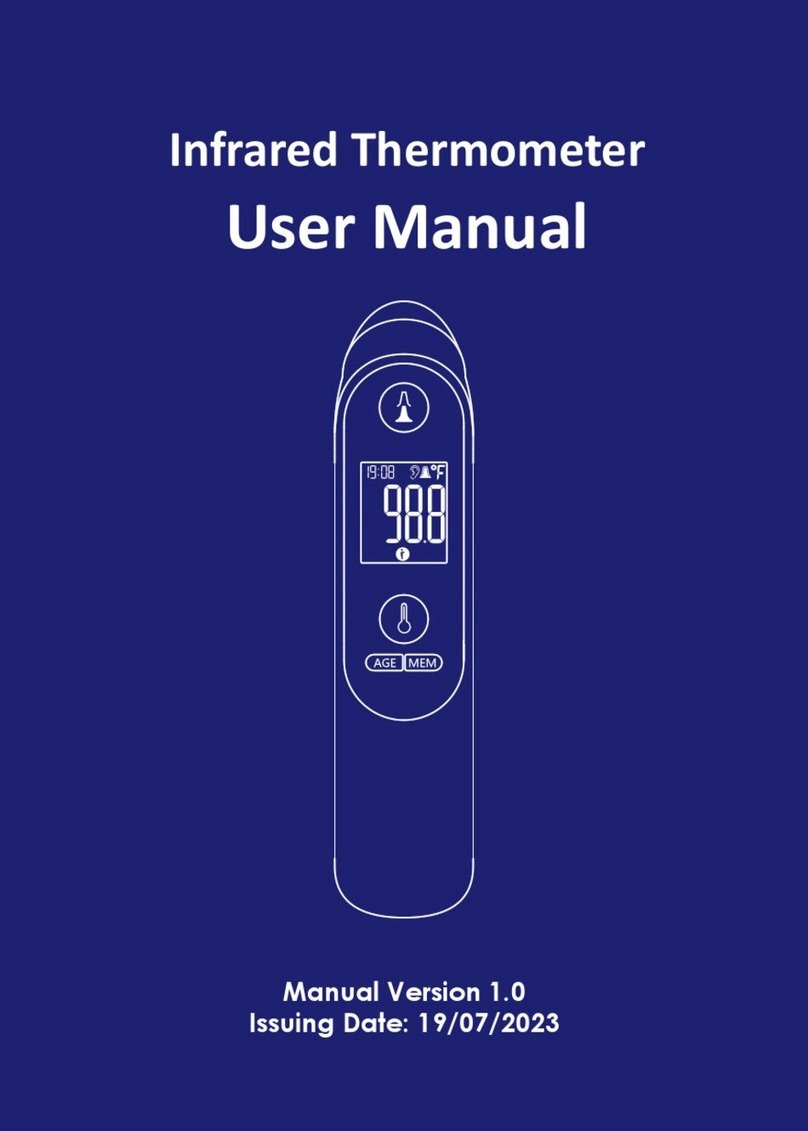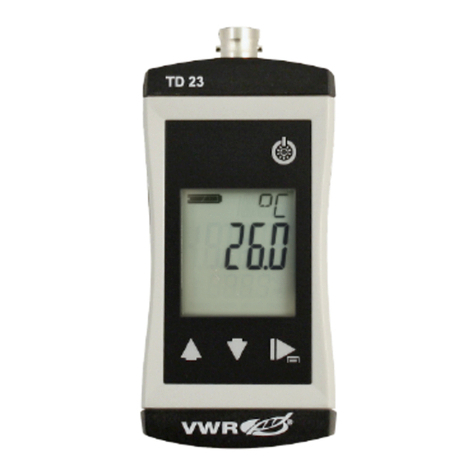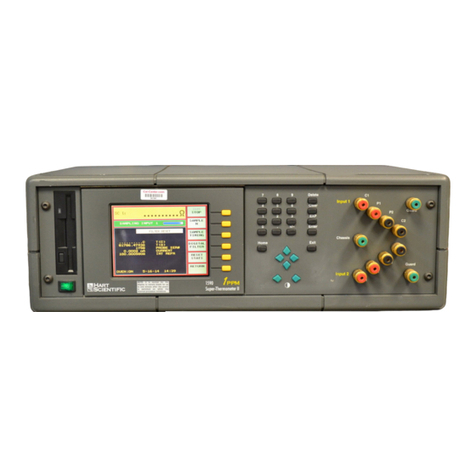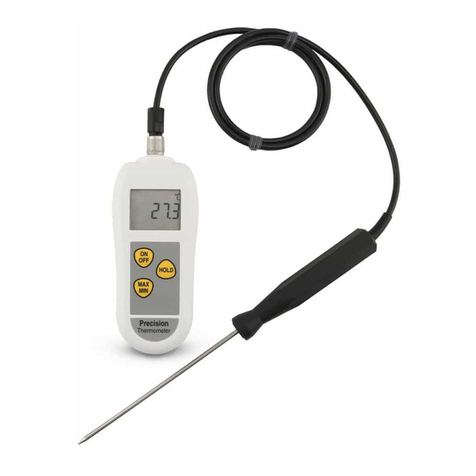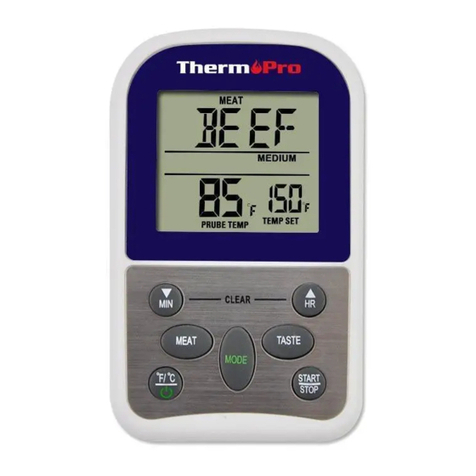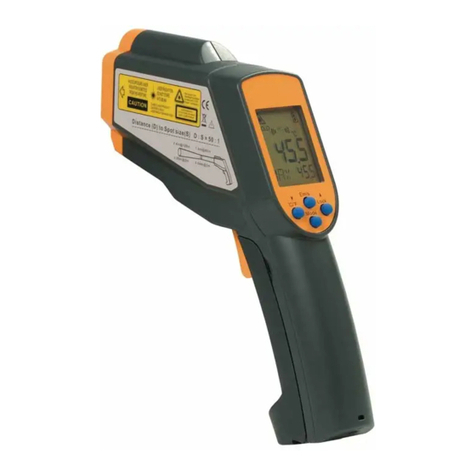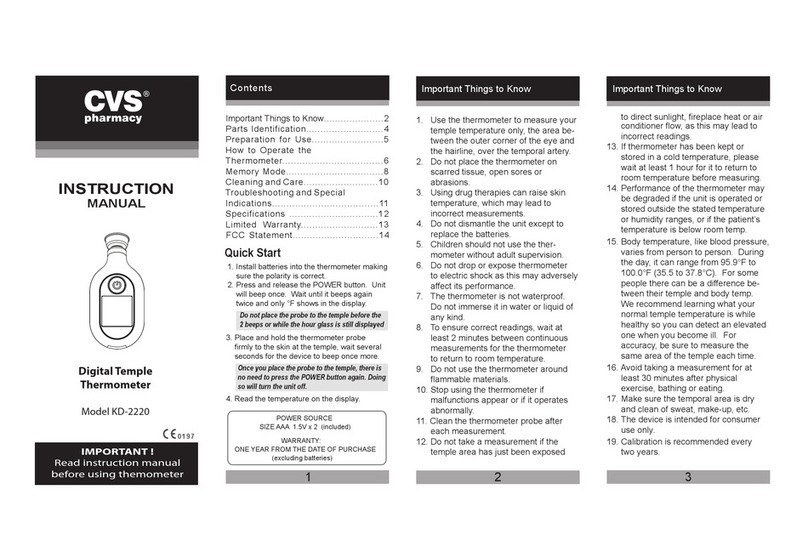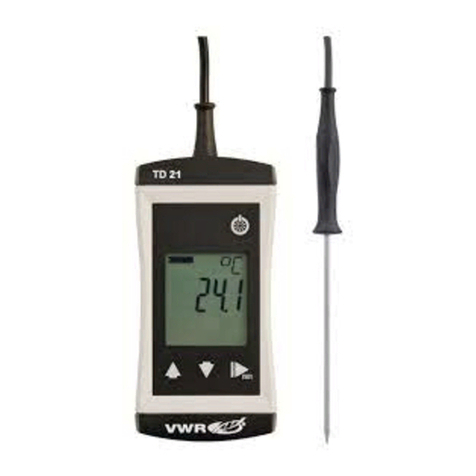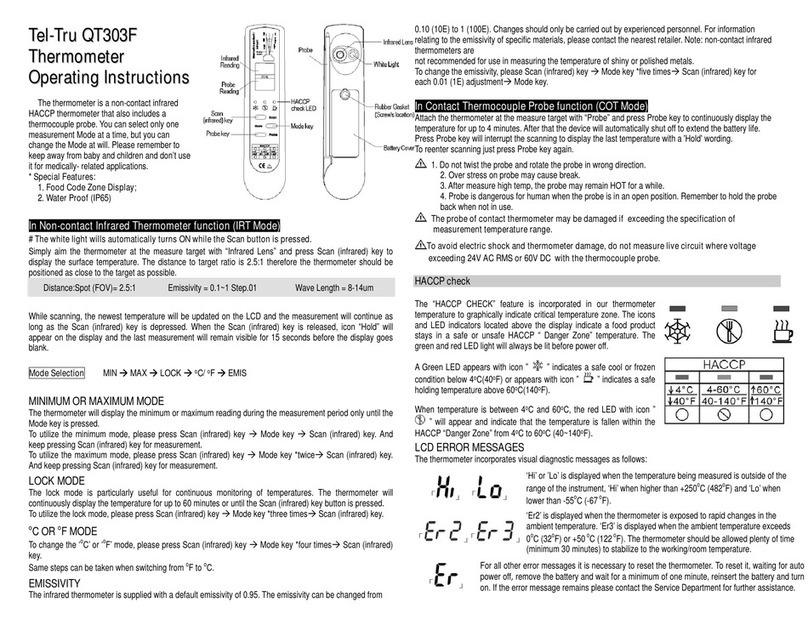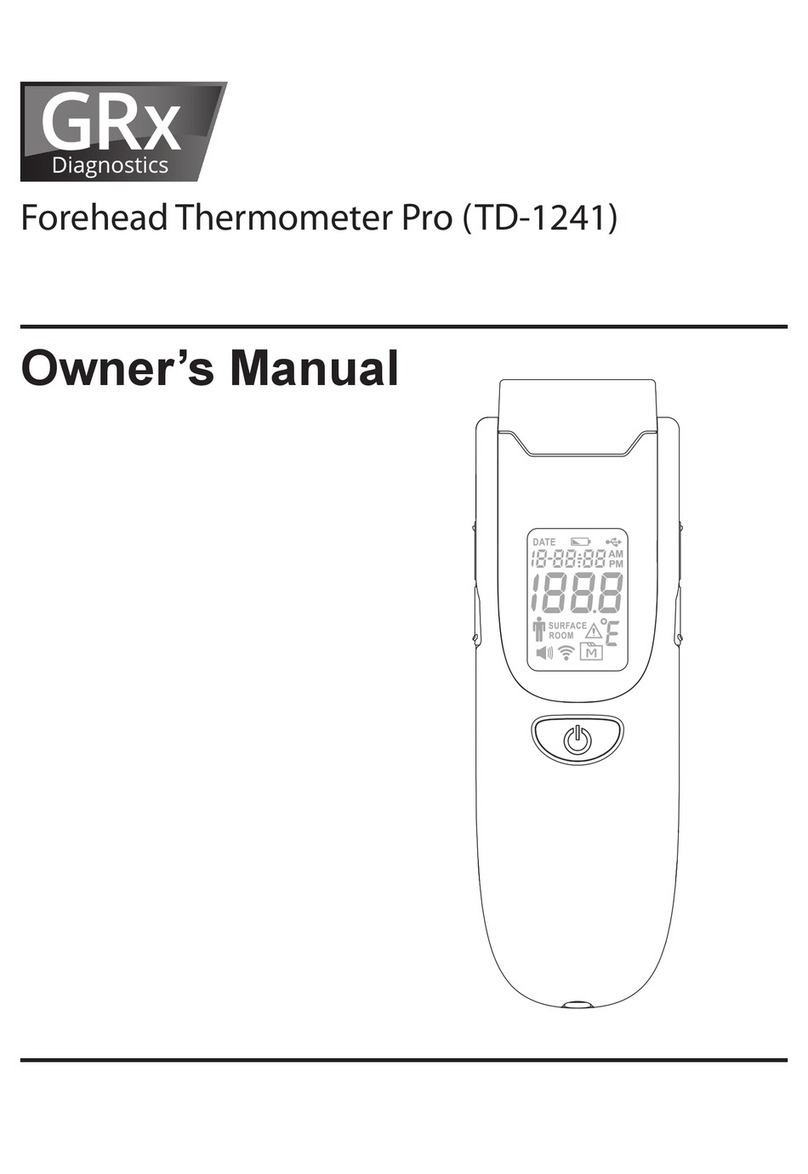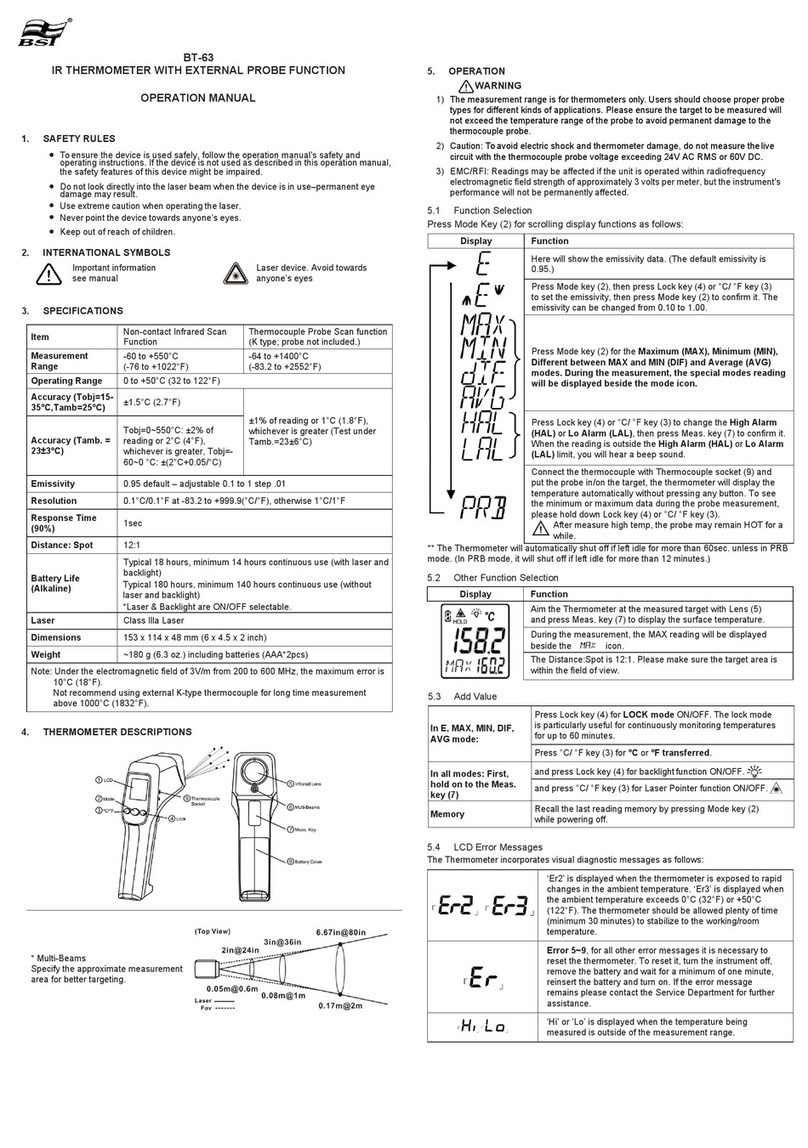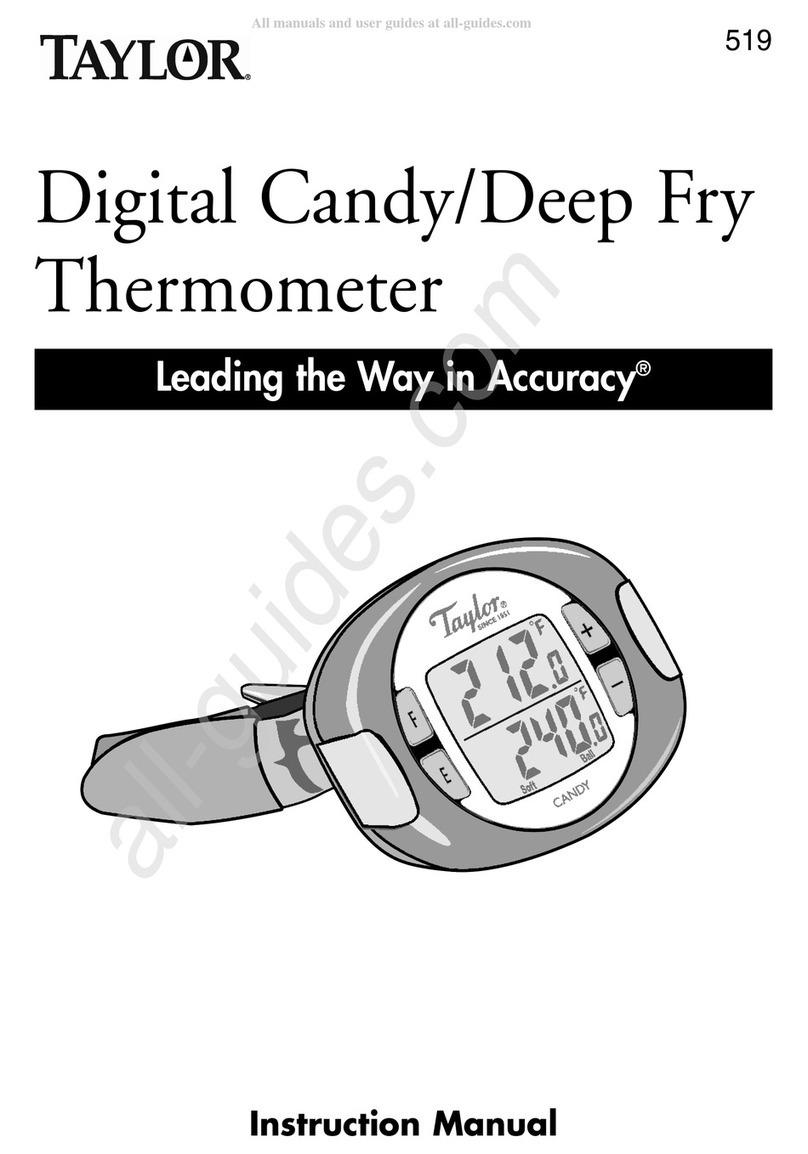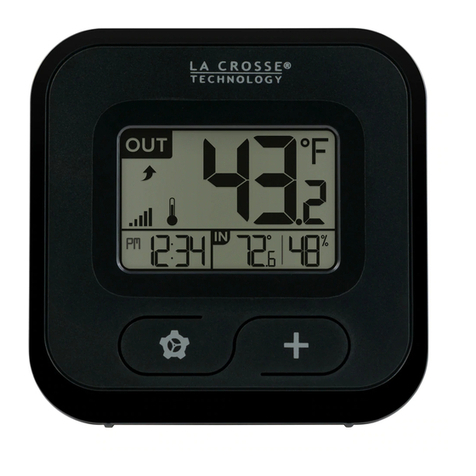Klein Tools IR5 User manual

INSTRUCTION MANUAL
IR5
2m
3
1m
FRANÇAIS pg. 21
ESPAÑOL pg. 11
Dual-laser Infrared
Thermometer
• DUAL-LASER
TARGETING
• 12:1 DISTANCE-
TO-SPOT RATIO
• AUTO-SCAN
• MAX/MIN/AVG/DIFF
• HIGH/LOW ALARM
• BACKLIT DISPLAY
• AUTO POWER-OFF
• ADJUSTABLE EMISSIVITY
ENGLISH
-22° – 752° F
(-30° – 400° C)

2
GENERAL SPECIFICATIONS
Klein Tools IR5 is a professional dual-laser targeting infrared
thermometer. It offers a wide measurement range, a tight distance-
to-spot ratio, dual targeting lasers, and several calculation modes to
facilitate different temperature measurement applications.
• Operating Altitude: 6562 ft. (2000 m)
• Relative Humidity: <85% non-condensing
• Operating Temp: 32°to 122°F (0°to 50°C)
• Storage Temp: -4°to 140°F (-20°to 60°C)
• Measurement Range: -22°to 752°F (-30°to 400°C)
• Units: Settable to °F or °C
• Emissivity: 0.10-1.00 adjustable
• Optical Resolution (Distance-to-spot): 12:1
• Dimensions: 6.83" x 4.53" x 1.85" (173 x 115 x 47 mm)
• Weight: 9.84 oz. (279 g) including battery
• Battery Type: 1 x 9V battery
• Battery Life: (Estimates assume 9V Zinc-Carbon Battery)
10 hours continuous use w/laser and backlight on.
• Display: Backlit LCD with white backlight
• Display Resolution: 0.1°F (0.1° C)
• Calibration: Accurate for one year
• Lasers: FDA and IEC Class II
• Standards: Certified to IEC EN 61326-1:2006,
EN608251:1994+A2:2001+A1:2002
• Pollution degree: 2
• Drop Protection: 6.6 ft. (2m)
• Electromagnetic Environment: IEC EN 61326-1. This
equipment meets requirements for use in basic and controlled
electromagnetic environments like residential properties,
business premises, and light-industrial locations.
Specifications subject to change.
ENGLISH

3
MEASUREMENT SPECIFICATIONS
• Response Time: <250ms
• Data hold: Yes
• MAX/MIN/Average/Differential: Yes
• Spectral Response: 8000-14000nm
≥32
°F
(≥0
°C
) ±4
°F
(±2
°C
) or ±2% (whichever is greater)
<32
°F
(<0
°C
)±(4
°F
+ 0.2
°F
per degree below 32
°F
)
±(2.2
°C
+ 0.2
°C
per degree below 0
°C
)
• Repeatability: ±0.8% of reading or ±2°F(±1°C)
(whichever is greater).
• Temperature Correction Coefcient:
±0.2°F per °F (±0.1°C per °C), or
±0.2% of reading (whichever is greater) when ambient temperature
is above or below 70 – 77°F (21 – 25°C).
Specifications subject to change.
WARNINGS
To ensure safe operation and service of the meter, follow these
instructions. Failure to observe these warnings can result in
severe injury or death.
• Do not direct laser beam into eyes, as this can cause permanent
eye damage.
• Do not use the meter if the case is damaged in any way.
• Replace the battery as soon as low battery indicator appears.
• Service the meter immediately if it is acting abnormally.
• Be cautious of readings of reflective materials as the meter
may indicate that these surfaces are cooler than their actual
temperature (see Emissivity section).
• Avoid using the meter around strong electromagnetic fields.
SAFE PRACTICES
This meter is designed for professionals who understand the hazards
associated with their trade. While this meter causes no foreseeable
dangers beyond its targeting lasers; the objects being measured,
as well as the environment in which they reside, can be hazardous.
Common safety practices to follow when operating near temperature
critical environments are:
• Follow the manufacturer's maintenance procedures when
servicing equipment.
• Before using this meter to determine if an area is safe, verify
correct operation by measuring a known temperature value of a
comparable object.
• Properly maintain this meter and calibrate it regularly.

4
13
2
4
5
1. Control button – Selects mode and moves down through menus
2. SET button – Sets selection
3. Control button – Turns targeting lasers on/off, turns backlight on/off,
moves up through menus
4. LCD Display
5. Trigger
6. Battery compartment door
7. IR temperature sensor
8. Targeting lasers
NOTE: There are no user-serviceable parts inside meter.
FEATURE DETAILS
ENGLISH
6
7
8
Front

5
SYMBOLS ON LCD
Indicates active measurement
Targeting lasers active
Backlight active
HOLD Data Hold
Low battery indicator
°F °C
Indicates active temperature scale
Indicates measurement mode
Emissivity
Hi Lo
High / Low temperature limit indicators
Enable / disable audible temperature limit alarms

6
ENGLISH
OPERATING INSTRUCTIONS
TEMPERATURE MEASUREMENT
To measure temperature with the IR5, aim the meter at the object to
be measured, pull the trigger
5
and hold it depressed for at least 2
seconds. Releasing the trigger initiates Data Hold, "HOLD" will show
on the display, and the measurement will be held on the display.
If the display shows "OL" or "–OL" following a measurement, this
indicates that the surface temperature of the object being measured
is either above or below the measurement range of the meter.
TARGETING
The IR5 features dual lasers
8
to assist in targeting the
measurement area. The distance between the two laser spots on the
surface of the object being measured approximates the diameter
of the circular measurement area from which the infrared sensor is
collecting data. Measurement areas located far away from the meter
will be larger than those close to the meter.
The meter is configured with 12:1 optical resolution (distance-to-spot
ratio). The distance-to-spot ratio defines the size of the measurement
area relative to the distance between the measurement location and
the IR sensor
7
. Typical diameters of the measurement area as a
function of the distance between the meter and the target area are
depicted below for 12:1 optical systems (Fig. 1).
Ø
0
.5"
(13 mm)
Ø
1"
(25 mm)
Ø
2"
(51 mm)
6"
(152 mm)
12"
(305 mm)
Ø
4"
(102 mm)
24"
(610 mm)
48"
(1219 mm)
Fig. 1
Distance-to-Spot
TARGETING LASERS
The targeting lasers
8
may be turned on/off by long presses of control
button
3
. When on, the laser icon " " will be visible on the display.

7
OPERATING INSTRUCTIONS
BACKLIGHT
The backlight may be toggled on/off by short presses of control
button
3
. When on, the backlight icon will be visible on the display.
MODE SELECTIONS
When measuring temperature the meter continuously samples the
object being measured. Following a measurement, repeatedly press
the mode control button
1
to cycle through:
• the maximum temperature value measured ("MAX").
• the average value measured ("AVG").
• the difference between maximum and minimum values
measured ("DIFF").
• the minimum value measured ("MIN").
• press once more to exit the MODE menu.
SETTINGS
User adjustable settings may be defined using the SET control button
2
.
Press SET
2
to enter the settings menu, subsequent presses of SET cycle
through the following list of options:
• emissivity: set the numerical value of the emissivity to match
the surface being measured (see EMISSIVITY section below).
When in this setting the emissivity icon will flash on the display.
• units: Switch between °F (Fahrenheit) and °C (Celsius). When
in this setting the "°F" or "°C" icon will flash on the display,
indicating the temperature scale that is currently active.
• mute temperature limit alarms: (turn audible limit alarms on/
off). When in this setting the audible icon " "will flash on the
display. When on, the high "
Hi
"/low "
Lo
" icons will be visible and
when off they will not be visible.
• high temperature limit setting: assign a numerical value to the
high temperature limit. When in this setting, the high icon "
Hi
"
will flash on the display.
• low temperature limit setting: assign a numerical value to the
low temperature limit. When in this setting, the low icon "
Lo
"
will flash on the display.
When in any setting, control buttons
1
and
3
function as up/down
to adjust settings and they may be used to select units, turn alarms
on or off, or adjust the numerical values of the respective parameters
up or down.

8
ENGLISH
OPERATING INSTRUCTIONS
EMISSIVITY
Emissivity is a measure of the ability of a surface to emit thermal
energy by radiation. Different types of surfaces (metals, masonry,
wood, etc.) emit thermal energy through radiation at different
efficiencies. Accordingly, these materials have different emissivity
coefficients which must be considered in order to make accurate
measurements with an infrared thermometer.
Emissivity on the IR5 may be adjusted from 0.10 to 1.00 to enable
accurate measurement of the temperature of most types of materials.
Generally speaking, shiny bright surfaces such as chrome, white
boards, etc. exhibit lower emissivity than flat black materials.
For guidance only, the chart below may be used to estimate
emissivity for many different types of materials. However, the
emissivity of surfaces is dependent upon many parameters such as
surface finish, temperature, shape of the object, etc.
This chart should be used for guidance only.
Material Emissivity
Asphalt 0.93
Red brick 0.93
Gray brick 0.75
Porcelain ceramic 0.92
Fired clay 0.91
Rough concrete 0.94
Cotton cloth 0.77
Smooth glass 0.92 - 0.94
Granite 0.45
Gravel 0.28
Smooth ice 0.97
Smooth white marble 0.56
Black paint 0.96
Hard rubber 0.94
Wood 0.80 - 0.90
Matte copper 0.22
Commercial sheet aluminum 0.09
Cold rolled steel 0.75 - 0.85
Find a comprehensive list of emissivity values at
www.kleintools.com/content/instructions

9
CUSTOMER SERVICE
KLEIN TOOLS, INC.
450 Bond Street
Lincolnshire, IL 60069
1-877-775-5346
www.kleintools.com
CLEANING
Be sure meter is turned off and wipe with a clean, dry lint-free
cloth.
Do not use abrasive cleaners or solvents.
Take care
to keep the sensor lens clean at all times. If required, loose
debris may be removed from lens using clean compressed air.
Lens may also be cleaned using a soft cloth or cotton swab
with water or rubbing alcohol
only
. Lens must be allowed to
completely dry prior to use.
STORAGE
Remove the battery when meter is not in use for a prolonged
period of time. Do not expose to high temperatures or
humidity. After a period of storage in extreme conditions
exceeding the limits mentioned in the General Specifications
section, allow the meter to return to normal operating
conditions before using.
WARRANTY
www.kleintools.com/warranty
DISPOSAL /RECYCLE
Do not place equipment and its accessories in the trash.
Items must be properly disposed of in accordance with local
regulations. Please see www.epa.gov or www.erecycle.org
for additional information.
MAINTENANCE
BATTERY REPLACEMENT
When indicator is displayed on LCD, battery must be replaced.
1. Open the battery compartment
6
by pulling the battery
compartment cover at the indentations away from the trigger.
2. Remove exhausted 9V battery and dispose of appropriately.
3. Replace 9V battery and return battery compartment cover,
ensuring that it locks into place.

ENGLISH
NOTES

MANUAL DE
INSTRUCCIONES
IR5
2m
3
1m
Termómetro
infrarrojo de
doble láser
• DOBLE LÁSER
DE ENFOQUE
DEL OBJETIVO
• RELACIÓN
DISTANCIA A
OBJETIVO 12:1
• AUTOESCANEO
• MÁX./MÍN./PROM./DIF.
• ALARMA ALTA/BAJA
• PANTALLA
RETROILUMINADA
• APAGADO AUTOMÁTICO
• AJUSTE DE EMISIVIDAD
ESPAÑOL
-22 °F a 752 °F
(-30 °C a 400 °C)

12
ESPECIFICACIONES GENERALES
El IR5 de Klein Tools es un termómetro infrarrojo profesional de
doble láser de enfoque del objetivo. Posee un amplio rango de
medición, una relación distancia a objetivo ajustada, doble láser
deenfoque del objetivo y varios modos de cálculo que lo ayudarán
en diferentes aplicaciones de medición de temperatura.
• Altitud de funcionamiento: 6562pies (2000m)
• Humedad relativa: <85% sin condensación
• Temperatura de operación: 32°F a 122°F (0°C a 50°C)
• Temperatura de almacenamiento: -4°F a 140°F (-20°C a 60°C)
• Rango de medición: -22°F a 752°F (-30°C a 400°C)
• Unidades: Se puede configurar en °F o °C
• Emisividad 0,10 a 1,00 ajustable
• Resolución óptica (distancia a objetivo): 12:1
• Dimensiones: 6,83" × 4,53" × 1,85" (173mm × 115mm × 47mm)
• Peso: 9,84 oz (279 g) incluidas la batería
• Tipo de batería: 1 batería de 9V
• Vida útil de la batería: (Los cálculos suponen el uso de una
batería de zinc-carbono de 9V)
10horas de uso continuo c/el láser
yla retroiluminación encendidos.
• Pantalla: LCD retroiluminada en blanco
• Resolución del visor: 0,1°F (0,1°C)
• Calibración: Precisa durante un año
• Láseres: FDA e IEC Clase II
• Normas: Cumple con las normas IEC EN 61326-1:2006 y
EN 608251:1994+A2:2001+A1:2002
• Grado de contaminación: 2
• Protección ante caídas: 6,6pies (2m)
• Entorno electromagnético: IEC EN 61326-1. Este equipo
cumple con los requisitos apropiados para su uso en entornos
electromagnéticos básicos y controlados como propiedades
residenciales, establecimientos comerciales e instalaciones de
industria ligera.
Especificaciones sujetas a cambios.
ESPAÑOL

13
ESPECIFICACIONES DE MEDICIÓN
• Tiempo de respuesta: <250ms
• Retención de datos: Sí
• MÁX./MÍN./Promedio/Diferencial: Sí
• Respuesta espectral: 8000nm a 14.000nm
≥ 32°F (≥ 0°C) ± 4°F (± 2°C) o ±2% (el valor que sea mayor)
< 32°F (< 0°C) ± (4°F + 0,2°F por cada grado por debajo de los 32°F)
± (2,2°C + 0,2°C por cada grado por debajo de los 0°C)
• Repetibilidad: ± 0,8% de la lectura o ± 2°F (± 1°C)
(el valor que sea mayor).
• Coeciente de corrección de temperatura: ± 0,2°F por cada °F
(±0,1°C por cada °C), o
±
0,2% de la lectura (el valor que sea
mayor) si la temperatura ambiente se encuentra fuera del rango
de 70°F a 77°F (21°C a 25°C).
Especificaciones sujetas a cambios.
ADVERTENCIAS
Para garantizar un funcionamiento y servicio seguros del
instrumento, siga estas instrucciones. El incumplimiento de estas
advertencias puede provocar lesiones graves o la muerte.
• No dirija el haz del láser directamente a los ojos, ya que puede
provocar daños oculares permanentes.
• No utilice el instrumento si está dañado.
• Reemplace la batería apenas aparezca el indicador de bajo nivelde
carga de batería.
• Repare el instrumento de inmediato si observa que actúa de
manera anormal.
• Actúe con prudencia respecto de las mediciones en materiales
reflectantes, dado que el instrumento puede indicar que están
a una temperatura menor que su temperatura real (consulte la
sección Emisividad).
• Evite utilizar el instrumento cerca de campos electromagnéticos
intensos.
PRÁCTICAS SEGURAS
El instrumento está diseñado específicamente para profesionales
que conocen los riesgos asociados con sus prácticas. Si bien este
instrumento no presenta ningún peligro previsible que supere el que
suponen los láseres de enfoque del objetivo, los objetos que se van
a medir, así como el entorno en que están, pueden ser peligrosos.
Acontinuación, se incluyen prácticas de seguridad comunes para
quienes trabajan cerca de entornos críticos de temperatura:
• Cuando realice algún servicio sobre el instrumento, siga los
procedimientos de mantenimiento del fabricante.
• Antes de utilizar el instrumento para determinar si un área es
segura, compruebe que funcione correctamente midiendo un
objeto semejante que tenga un valor de temperatura conocido.
• Realice el mantenimiento adecuado del instrumento y calíbrelo
regularmente.

14
13
2
4
5
6
7
8
Parte
delantera
1. Botón de control – Sirve para seleccionar modos y para
desplazarse hacia abajo por los menús.
2. Botón SET
(CONFIGURAR) – Sirve para configurar opciones.
3. Botón de control – Sirve para activar y desactivar los láseres
de enfoque del objetivo, para encender
y apagar la retroiluminación y para
desplazarse hacia arriba por los menús.
4. Pantalla LCD
5. Gatillo
6. Tapa del compartimento de la batería
7. Sensor de temperatura IR
8. Láseres de enfoque del objetivo
NOTA: El instrumento no contiene en su interior piezas que
elusuario pueda reparar.
DETALLES DE LAS CARACTERÍSTICAS
ESPAÑOL

15
SÍMBOLOS DE LA PANTALLA LCD
Indica que la medición está activada.
Indica que los láseres de enfoque del objetivo
estánactivados.
Indica que la retroiluminación está encendida.
HOLD Retención de datos
Indicador de batería baja.
°F °C
Indica qué escala de temperatura está activada.
Indica el modo de medición.
Emisividad
HI Lo
Indicadores de límite de temperatura alta/baja.
Indica si las alarmas audibles de límite de temperatura
están activadas o desactivadas.

16
ESPAÑOL
INSTRUCCIONES DE OPERACIÓN
MEDICIÓN DE TEMPERATURA
Para medir temperatura con el IR5, apunte el instrumento hacia
el objeto que desea medir y mantenga presionado el gatillo
5
durante 2segundos como mínimo. Cuando suelte el gatillo, se
retendrán los datos (se visualizará "HOLD" en la pantalla) y la
medición permanecerá en la pantalla. Si la pantalla muestra "OL"
o "–OL" después de una medición, quiere decir que la temperatura
de la superficie del objeto que está midiendo se encuentra fuera del
rango de medición del instrumento.
ENFOQUE DEL OBJETIVO
El IR5 tiene dos láseres
8
que ayudan a enfocar el área que se
medirá. La distancia entre los dos puntos láser en la superficie del
objeto que se va a medir se aproxima al diámetro del área circular
de medición de donde el sensor infrarrojo recopila los datos. Las
áreas de medición situadas lejos del instrumento son más extensas
que las cercanas al instrumento.
El instrumento está configurado con una resolución óptica 12:1
(relación distancia a objetivo). La relación distancia a objetivo
determina el tamaño del área de medición relativa a la distancia
entre el punto de medición y el sensor IR
7
. A continuación, se
ilustran los diámetros típicos del área de medición como función
de la distancia entre el instrumento y el área objetivo para sistemas
ópticos 12:1 (Fig. 1).
Ø
0
.5"
(13 mm)
Ø
1"
(25 mm)
Ø
2"
(51 mm)
6"
(152 mm)
12"
(305 mm)
Ø
4"
(102 mm)
24"
(610 mm)
48"
(1219 mm)
Fig. 1
Relación distancia a objetivo
LÁSERES DE ENFOQUE DEL OBJETIVO
Los láseres de enfoque del objetivo
8
se pueden activar y desactivar
presionando el botón de control
3
por tiempo prolongado. Cuando
están activados, el icono de láser " " se visualiza en la pantalla.

17
INSTRUCCIONES DE OPERACIÓN
RETROILUMINACIÓN
La retroiluminación se puede encender y apagar presionando
brevemente el botón de control
3
. Cuando está encendida, el
icono de retroiluminación se visualiza en la pantalla.
SELECCIÓN DE MODOS
Al medir temperatura, el instrumento toma continuamente muestras
del objeto que se está midiendo. Después de una medición, presione
el botón de control de modo
1
varias veces para recorrer en ciclo:
• el valor de temperatura máxima medido ("MAX").
• el valor promedio medido ("AVG").
• la diferencia entre los valores máximo y mínimo medidos
("DIFF").
• el valor mínimo ("MIN").
• vuelva a presionar el botón para salir del menú MODE.
AJUSTES
El usuario puede definir ajustes utilizando el botón de control SET
2
.
Presione SET
2
para ingresar al menú de ajustes; presionar varias
veces este botón le permite recorrer cíclicamente la siguiente lista
de opciones:
• Emisividad: configure el valor numérico de emisividad para que
coincida con el de la superficie que desea medir (consulte la
sección EMISIVIDAD más adelante). Al seleccionar este ajuste,
el icono de emisividad empieza a parpadear en la pantalla.
• Unidades: alterne entre °F (Fahrenheit) y °C (Celsius). Al
seleccionar este ajuste, el icono "°F" o "°C" comienza a parpadear
en la pantalla para indicar qué escala de temperatura está activada.
• Silenciar alarmas de límite de temperatura: (permite activar o
desactivar las alarmas audibles de límite de temperatura). Al
seleccionar este ajuste, el icono audible de emisividad " " empieza
a parpadear en la pantalla. Cuando las alarmas están activadas, los
iconos "
HI
" (alto)/"
Lo
" (bajo) se visualizan en la pantalla; cuando
están desactivadas, los iconos desaparecen de la pantalla.
• Configuración del límite de temperatura alta: asígnele un valor
numérico al límite de temperatura alta. Al seleccionar este
ajuste, el icono "
HI
" (alto) empieza a parpadear en la pantalla.
• Configuración del límite de temperatura baja: asígnele un valor
numérico al límite de temperatura baja. Al seleccionar este
ajuste, el icono "
Lo
" (bajo) empieza a parpadear en la pantalla.
En cualquiera de las opciones de ajuste, los botones de control
1
y
3
sirven para desplazarse hacia arriba y hacia abajo
para configurar los ajustes, y también se los puede utilizar para
seleccionar unidades, activar o desactivar las alarmas o aumentar
odisminuir los valores numéricos de los respectivos parámetros.

18
ESPAÑOL
INSTRUCCIONES DE OPERACIÓN
EMISIVIDAD
La emisividad es la medición de la capacidad de una superficie
para emitir energía térmica por radiación. Distintas superficies
(metálicas, de concreto, de madera, etc.) emiten energía térmica
a través de la radiación, pero su eficiencia varía. Por consiguiente,
estos materiales poseen diferentes coeficientes de emisividad que
se deben tener en cuenta para obtener mediciones precisas con el
termómetro infrarrojo.
La emisividad del IR5 se puede ajustar entre 0,10 y 1,00 para lograr
mediciones precisas en la mayoría de los tipos de materiales. En
términos generales, las superficies brillantes y lustrosas, como el
cromo, las placas blancas, etc., tienen una emisividad más baja que
los materiales uniformes de color negro.
La siguiente tabla, que debe utilizarse solo como referencia,
sirve para calcular la emisividad de muchos tipos de materiales
diferentes. Sin embargo, la emisividad de las superficies depende
de muchos parámetros, como el acabado y la temperatura de la
superficie, la forma del objeto, etc.
Esta tabla debe usarse solo como referencia.
Material Emisividad
Asfalto 0,93
Ladrillo rojo 0,93
Ladrillo gris 0,75
Cerámica porcelana 0,92
Arcilla cocida 0,91
Hormigón rugoso 0,94
Tela de algodón 0,77
Vidrio liso 0,92 - 0,94
Granito 0,45
Grava 0,28
Hielo liso 0,97
Mármol blanco liso 0,56
Pintura negra 0,96
Ebonita 0,94
Madera 0,80 - 0,90
Cobre mate 0,22
Plancha de aluminio comercial 0,09
Acero laminado en frío 0,75 - 0,85
Obtenga una lista completa de valores de emisividad en
www.kleintools.com/content/instructions.

19
SERVICIO AL CLIENTE
KLEIN TOOLS, INC.
450 Bond Street
Lincolnshire, IL 60069
1-877-775-5346
www.kleintools.com
LIMPIEZA
Asegúrese de que el instrumento esté apagado y límpielo
con un paño limpio, seco, que no deje pelusas.
No utilice
solventes ni limpiadores abrasivos.
Mantenga la lente del
sensor siempre limpia. Si debe retirar partículas sueltas de
la lente, emplee aire comprimido limpio. La lente también
se puede limpiar con un paño suave o hisopo de algodón
embebidos en agua, o frotándola
solo
con alcohol. Deje que la
lente se seque completamente antes de utilizarla.
ALMACENAMIENTO
Retire la batería si no va a utilizar el instrumento durante un
tiempo prolongado. No lo exponga a la humedad ni a altas
temperaturas. Luego de un período de almacenamiento
en condiciones extremas que sobrepasen los límites
mencionados en la sección Especificaciones generales, deje
que el instrumento vuelva a las condiciones de funcionamiento
normales antes de utilizarlo.
GARANTÍA
www.kleintools.com/warranty
ELIMINACIÓN/RECICLAJE
No arroje el equipo ni sus accesorios a la basura.
Los elementos se deben desechar correctamente de
acuerdo con las regulaciones locales. Para obtener más
información, consulte www.epa.gov o www.erecycle.org.
MANTENIMIENTO
REEMPLAZO DE La batería
Cuando aparece el indicador en la pantalla LCD, se deben
reemplazar la batería.
1. Abra el compartimento de la batería
6
tirando de la tapa por las
muescas hacia el lado opuesto del gatillo.
2. Retire la batería de 9V gastada y deséchela adecuadamente.
3. Instale otra batería de 9V, vuelva a colocar la tapa del compartimento
de la batería y compruebe que quede bloqueada en su posición.

ESPAÑOL
NOTAS
Other manuals for IR5
1
Table of contents
Languages:
Other Klein Tools Thermometer manuals
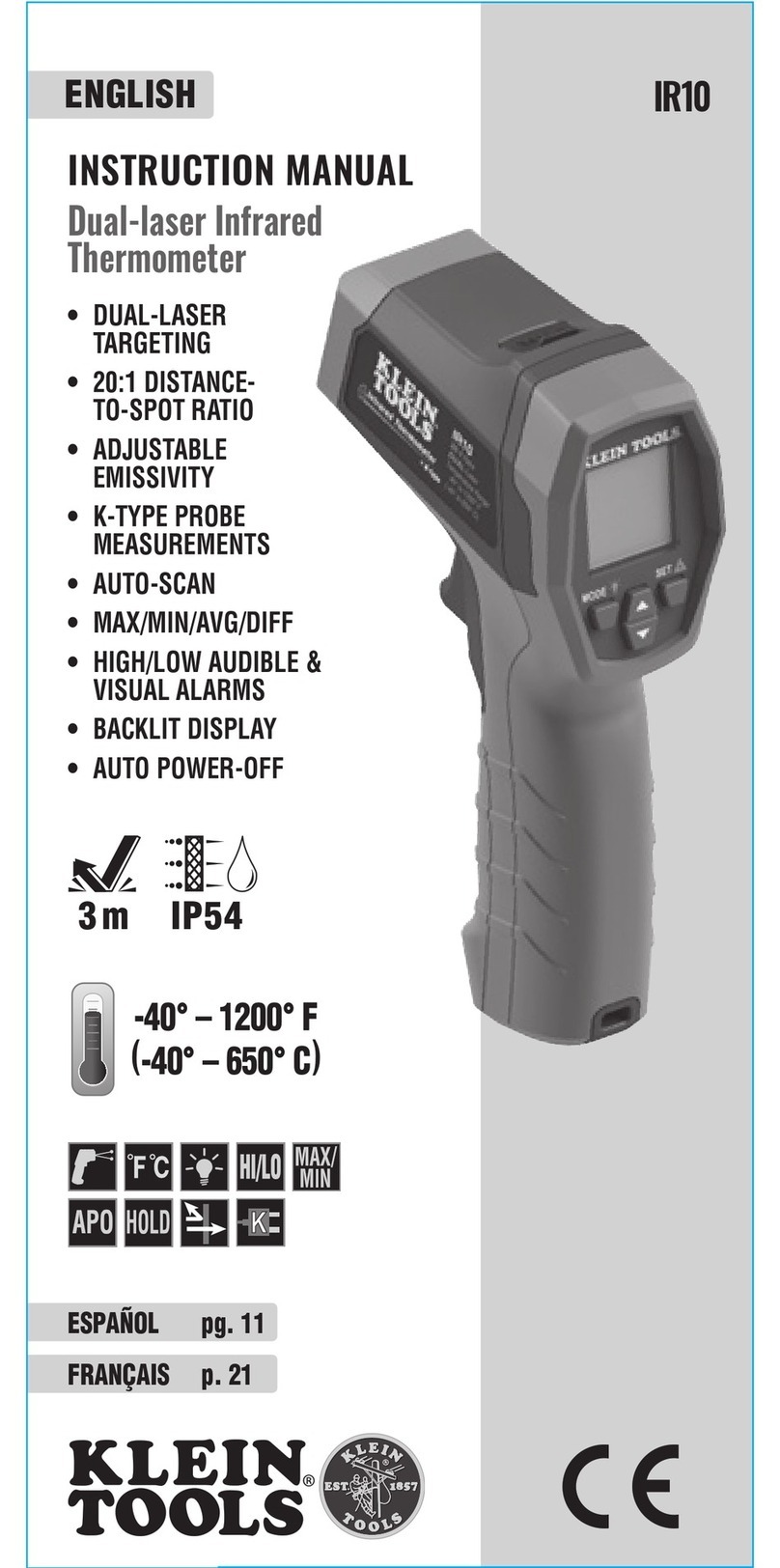
Klein Tools
Klein Tools IR10 User manual
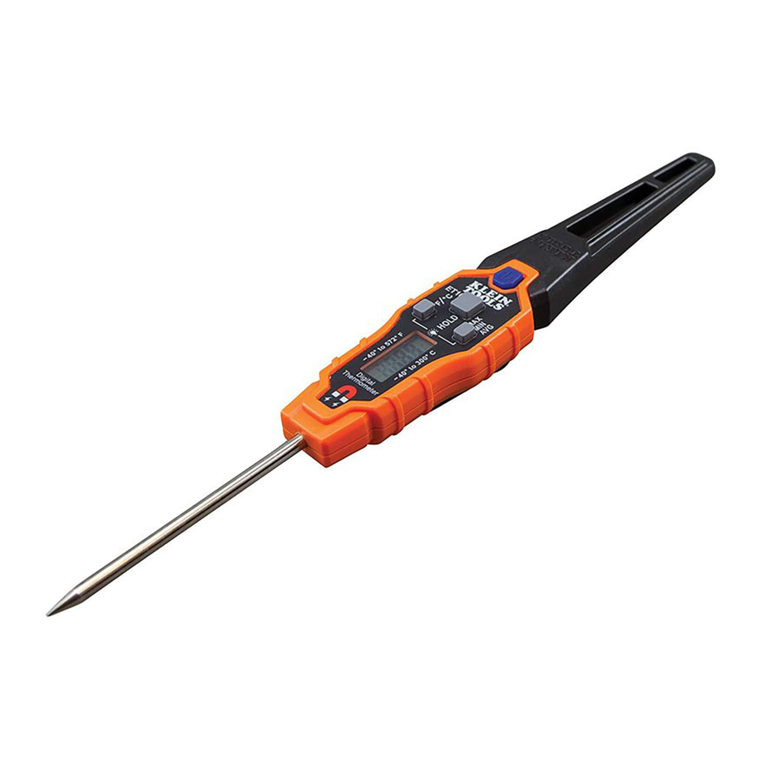
Klein Tools
Klein Tools ET10 User manual
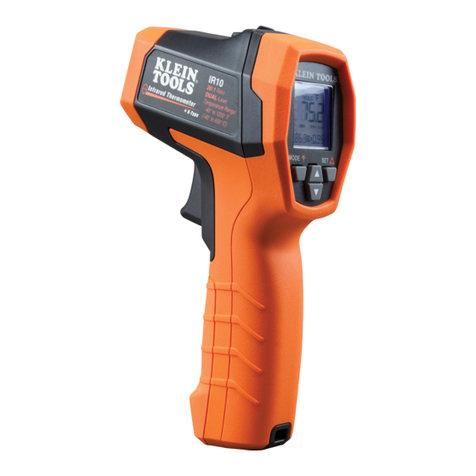
Klein Tools
Klein Tools IR10 User manual
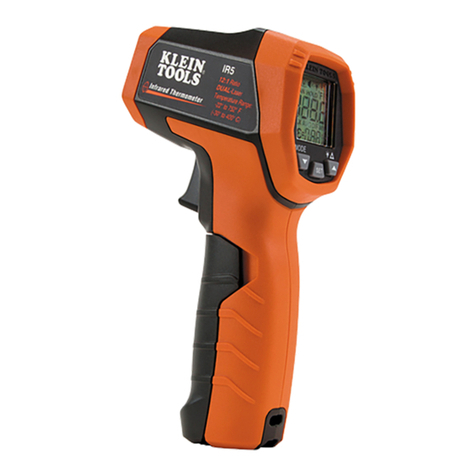
Klein Tools
Klein Tools IR5A User manual

Klein Tools
Klein Tools IR3000 User manual

Klein Tools
Klein Tools IR1 User manual
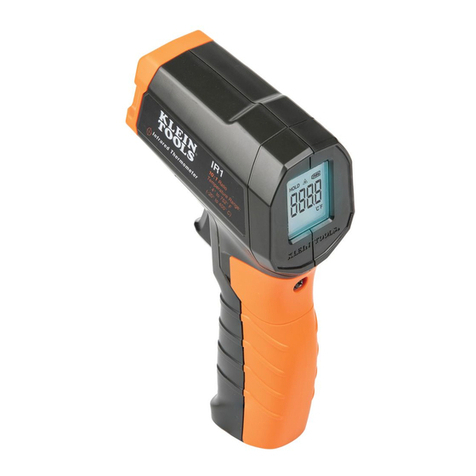
Klein Tools
Klein Tools IR1KIT User manual
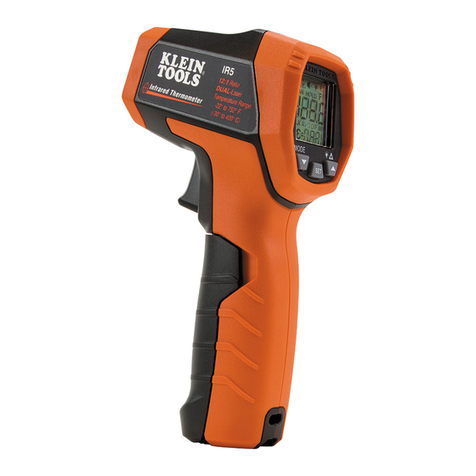
Klein Tools
Klein Tools IR5 User manual
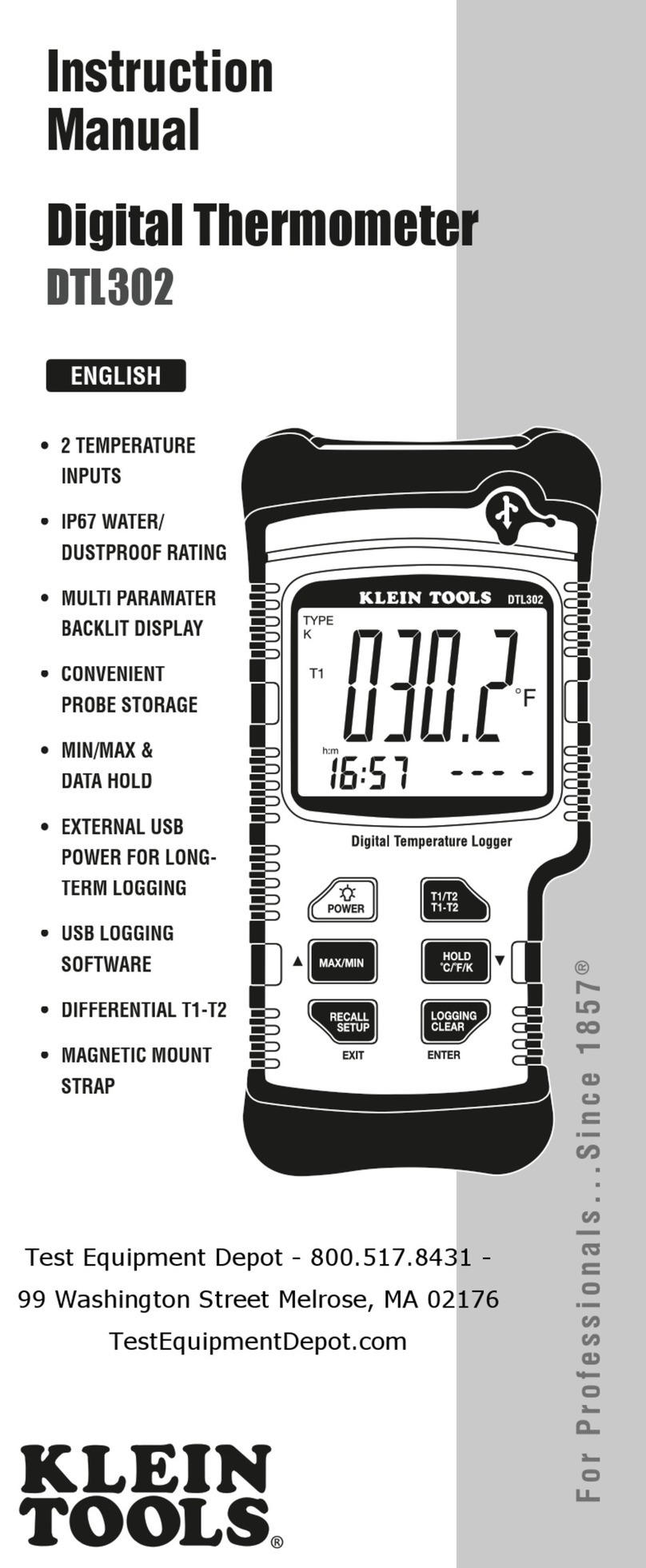
Klein Tools
Klein Tools DTL302 User manual
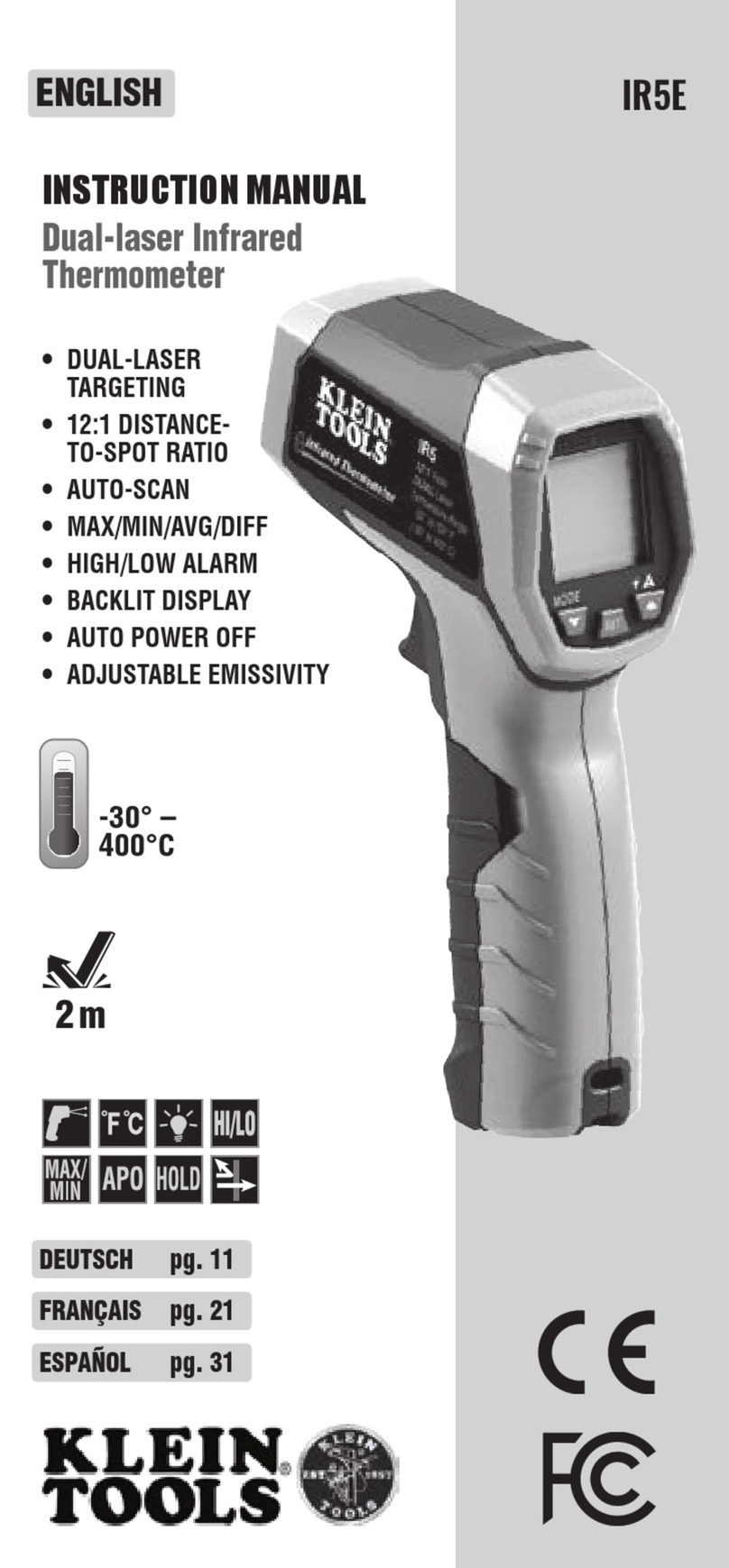
Klein Tools
Klein Tools IR5E User manual
